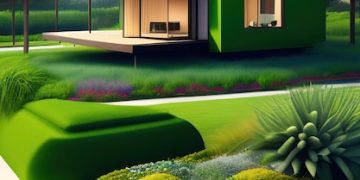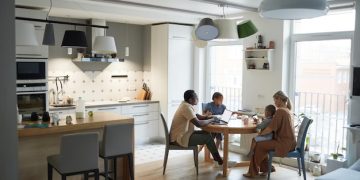Modular Homes: Are They the Future of Affordable Housing in 2025?
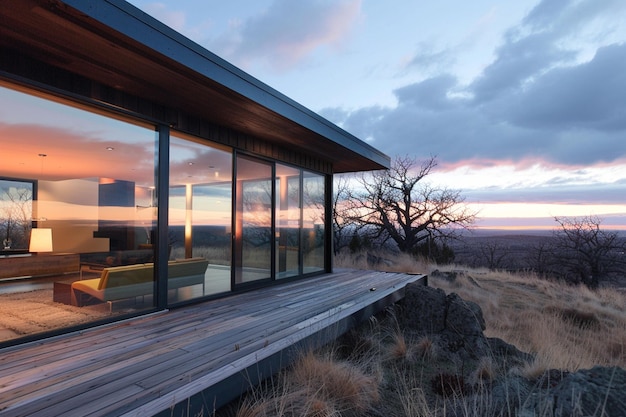
Modular homes are increasingly viewed as a viable solution to the affordable housing crisis in 2025, offering faster construction times, reduced costs, and customizable designs compared to traditional building methods.
Are modular homes poised to revolutionize the housing market by 2025? With rising construction costs and increasing demand for affordable housing, many are turning to modular construction as a faster, more sustainable, and cost-effective alternative.
Modular Homes: An Overview
Modular homes are changing the way we think about construction. They offer a unique blend of affordability, speed, and customization that’s becoming increasingly appealing. Let’s delve into what makes modular homes a compelling option for the future.
What Are Modular Homes?
Modular homes are prefabricated buildings composed of repeated sections called modules. These modules are constructed in a factory setting and then transported to the building site. Once on-site, they are assembled on a permanent foundation to create a complete home.
Benefits of Modular Homes
The key advantages of modular construction include reduced construction time, lower costs due to efficient factory production, and the ability to customize designs to meet specific needs. Additionally, modular construction can be more environmentally friendly by minimizing waste.
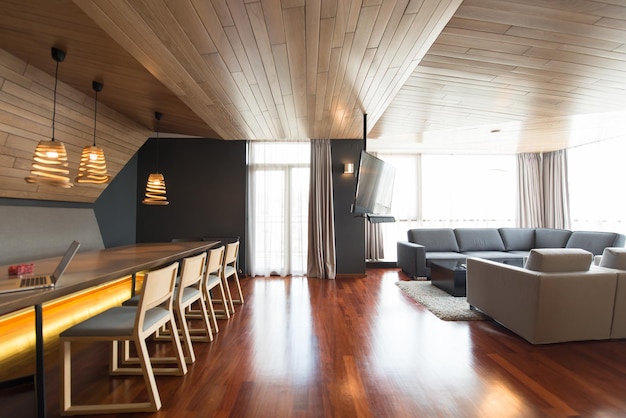
- Faster Construction: Modules are built simultaneously with site preparation, significantly reducing overall project time.
- Cost-Effective: Factory production minimizes waste and labor costs, making modular homes more affordable.
- Customizable Designs: Modular homes can be designed to fit various styles and preferences, offering flexibility in layout and appearance.
Modular homes offer a practical solution for those seeking quicker and more affordable housing options. Their adaptability and efficiency make them strong contenders in the evolving housing market.
The Rising Demand for Affordable Housing
The demand for affordable housing is a pressing issue across the United States. Economic factors, population growth, and urbanization contribute to this growing need. Understanding these drivers is crucial to appreciate the potential of modular homes.
Economic Factors
Rising costs of traditional construction, including materials and labor, have made homeownership increasingly unaffordable for many. This economic strain is driving the search for more cost-effective alternatives like modular homes.
Population Growth and Urbanization
As populations grow and more people move to urban areas, the demand for housing increases. This surge in demand puts pressure on the existing housing supply, making it more expensive and less accessible.
The Role of Modular Homes
Modular homes can help address the affordable housing crisis by providing cost-effective and rapidly deployable housing solutions. Their factory-built nature allows for quick construction and reduced expenses compared to traditional methods.
- Addressing Affordability: Modular homes reduce initial investment, making homeownership more accessible.
- Speeding Up Construction: Faster build times help meet the urgent demand for housing.
- Offering Scalable Solutions: Modular design allows for efficient construction of multiple units in a short period.
The confluence of economic pressures and population growth underscores the critical need for innovative housing solutions. Modular homes are positioned as a viable option to alleviate these challenges.
Modular Homes vs. Traditional Construction
Understanding the differences between modular homes and traditional construction is essential to appreciate the advantages of modular building. Let’s explore the key distinctions in terms of cost, time, and quality.
Cost Comparison
Modular homes typically cost less than traditionally built homes. This is primarily due to the efficiencies of factory production, reduced labor costs, and minimal material waste. The controlled environment of a factory also helps prevent weather-related delays and damages.
Time Efficiency
Modular construction is significantly faster than traditional building. Modules are constructed in a factory while the foundation is prepared on-site. This parallel process dramatically shortens the overall construction timeline. Once the modules are delivered, assembly is quick, often taking just a few days or weeks.
Quality and Customization
Despite misconceptions, modular homes can be of equal or even higher quality than traditionally built homes. Factory construction allows for rigorous quality control. Additionally, modular homes can be highly customized to meet individual preferences and design requirements.
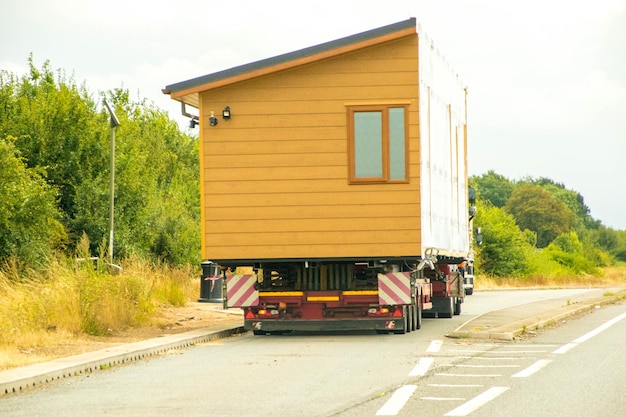
- Factory Precision: Controlled environments ensure consistent quality and reduce errors.
- Parallel Processes: Construction and site preparation occur simultaneously, saving time.
- Design Flexibility: Modular homes can be tailored to various architectural styles and personal tastes.
Modular homes offer a compelling alternative to traditional construction, combining cost savings, time efficiency, and design flexibility. These advantages make them an appealing choice for a wide range of homebuyers.
The Role of Technology in Modular Construction
Technology is playing an increasingly significant role in the advancement of modular construction. Innovations in design, manufacturing, and assembly are enhancing the efficiency and quality of modular homes.
Advanced Design Software
Sophisticated software like Building Information Modeling (BIM) allows architects and engineers to create detailed 3D models of modular homes. This technology improves design accuracy, reduces errors, and facilitates collaboration among different teams.
Automated Manufacturing Processes
Automation in factories is streamlining the production of modular components. Robots and automated systems can perform repetitive tasks with greater precision and speed, leading to higher quality and reduced costs.
Sustainable Materials and Practices
Modular construction is also embracing sustainable materials and practices. Eco-friendly materials, energy-efficient designs, and waste reduction strategies are becoming more common, making modular homes a greener option.
The integration of technology is revolutionizing modular construction, making it more efficient, sustainable, and adaptable to diverse needs.
Challenges and Solutions for Modular Homes
While modular homes offer numerous advantages, there are also challenges to consider. Addressing these obstacles is essential for the widespread adoption of modular construction.
Financing and Appraisal Issues
One challenge is securing financing for modular homes. Lenders may be unfamiliar with modular construction and hesitant to provide loans. Additionally, appraisals can be complicated because appraisers may not have sufficient data on comparable modular homes.
Zoning and Regulatory Hurdles
Zoning regulations and building codes can sometimes hinder modular construction. Some municipalities may have outdated or restrictive rules that do not accommodate modular building techniques. Overcoming these regulatory barriers requires education and advocacy.
Public Perception
Public perception is another hurdle. Some people still associate modular homes with low-quality or unattractive designs. Changing this perception requires showcasing the high-quality, customizable, and aesthetically pleasing aspects of modern modular homes.
- Education and Advocacy: Educating lenders and policymakers about the benefits of modular homes.
- Standardization of Codes: Promoting standardized building codes that recognize and support modular construction.
- Marketing and Showcasing: Highlighting attractive and high-quality modular home designs to improve public perception.
Addressing these challenges will pave the way for greater acceptance and utilization of modular homes. By overcoming these hurdles, modular construction can fulfill its potential as a viable housing solution.
The Future of Modular Homes in 2025 and Beyond
Looking ahead to 2025 and beyond, modular homes are poised to play a significant role in shaping the future of housing. Several trends and developments are expected to drive the growth of modular construction.
Increased Adoption
As awareness of the benefits of modular homes grows, we can expect to see increased adoption across various sectors. From single-family homes to multi-unit developments, modular construction will become more prevalent.
Technological Advancements
Continued advancements in technology will further enhance the efficiency and quality of modular homes. Innovations in automation, materials, and design will make modular construction even more competitive.
Sustainability Focus
Sustainability will remain a key driver. Modular homes will increasingly incorporate eco-friendly materials, energy-efficient designs, and waste reduction strategies, aligning with global efforts to promote sustainable building practices.
The future of modular homes is bright, with increasing adoption, technological advancements, and a strong focus on sustainability set to transform the housing landscape.
| Key Point | Brief Description |
|---|---|
| 🏠 Affordability | Modular homes offer cost savings due to efficient production and reduced labor costs. |
| ⏱️ Time Efficiency | Modular construction significantly reduces build times compared to traditional methods. |
| 🛠️ Customization | Modular homes can be designed to meet specific preferences and architectural styles. |
| 🌱 Sustainability | Eco-friendly materials and waste reduction make modular homes a greener option. |
Frequently Asked Questions
▼
Modular homes offer faster construction, cost-effectiveness, and customizable designs. Built in factories, they ensure quality and reduce waste, making them a sustainable choice.
▼
Yes, modular homes can be just as durable, if not more so. They are built to meet the same building codes and often undergo rigorous quality control in the factory.
▼
Modular homes offer a high degree of customization. You can choose from various floor plans, finishes, and architectural styles to create a home that fits your needs and preferences.
▼
Financing for modular homes is similar to traditional homes. You can explore mortgages, construction loans, and other financing options through banks and credit unions, or specialized lenders.
▼
Modular homes reduce waste through efficient factory production and often incorporate sustainable materials. They also facilitate energy-efficient designs, contributing to a lower environmental footprint.
Conclusion
As we look to 2025, modular homes stand out as a promising solution to the pressing need for affordable and sustainable housing. Their unique combination of speed, cost-effectiveness, and design flexibility positions them as a key player in the future of living.
